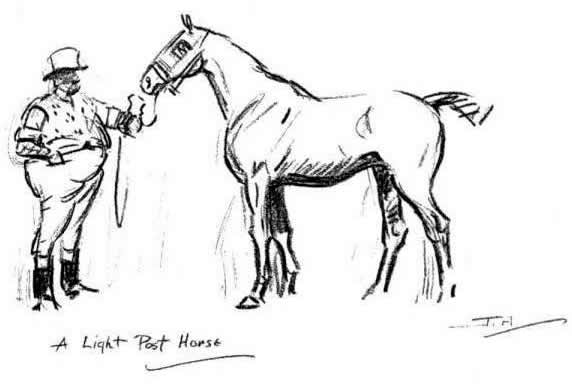This was Joe's first completed site and contains the full transcript and most of the illustrations for his unpublished book "Riding through the Ridings", which was conceived by Joe in 1947 and remained unpublished until the advent of the web. For visitors from outside our wonderful county of Yorkshire it may be worth noting Yorkshire was divided into three "Thridings" or "Ridings", North, East and West. In the course of your "Riding
through the Ridings" IF YOU JUST WISH TO SCROLL THE SKETCHES CLICK THE SCROLL BAR
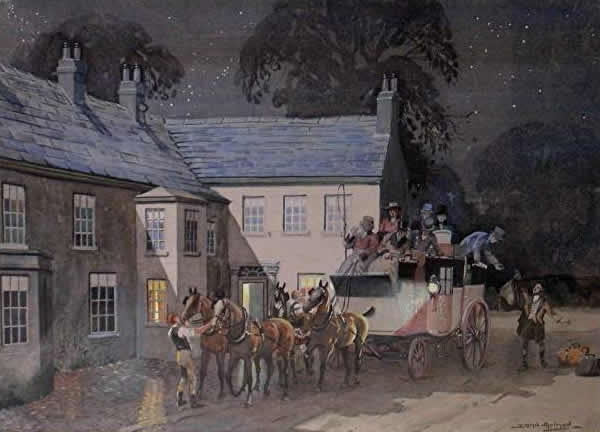
(RANDOM SKETCHES OF YORKSHIRE COACHING INNS) WRITTEN AND ILLUSTRATED WITH AN INTRODUCTION THE LOTUS PRESS, YORK
NEXT
NEXT
"YO-HO! DOWN COUNTLESS TURNINGS AND
THROUGH COUNTLESS from
NEXT
Page No TOP ,I,II,III,IV,V,VI,1,2,3,4,5,6,7,8,9,10,11,12,13,14,15,16,17,18,19,20,21,22,23,24,25,26,27,28,29,30,31,32,33,34,35,36,37 NEXT
by MAJOR J. FAIRFAX-BLAKEBOROUGH M.C. Some of us are old enough to have talked with the last of the drivers of stage coaches, with post-boys and quaint old ostlers, who could recall the music of the fast-trotting horses and the note on the guard's horn. Such have heard at first hand of all the bustle there was when the four steaming horses were to be speedily changed, relieved by others standing in readiness for the next stage. More there are who remember the long rows of stables, loose-boxes, saddle rooms and post-boy's quarters -- unused and maybe derelict -- in the spacious yards of the old coaching inns. These have also lived to see the end of coach-horse breeding in Yorkshire and the passing of the fairs in the country, at which hundreds of animals were yearly bought to horse the coaches in various parts of the country. Later, in pre-motor days, the best carriage-horses were sold in large numbers at these same Yorkshire fairs; to buyers from all over the world. The horse fairs as they declined, were the swan song of the long ranges of stabling, which were an essential adjunct and integral part of every coaching inn. All this formed the last remaining links with the spacious, leisurely, picturesque coaching-days. Of the actual living witnesses none are now left and now most of the old coaching houses have lost much of their character and once essential appendages, which stamped them for what they were. In some cases they have ceased to exist as hostelries, in others they have been much modernised as "road houses"; in nearly all revolution in travel has inevitably resulted in the stabling being converted into garages, put to other use, or dismantled. It is therefore much more difficult for those of this generation to conjure up in imagination the poetry of the road as it existed when Dickens, Washington Irving and others painted such delightful word pictures of coaching and the hospitality and busy-ness of the coaching inns. Yet all this was obtained only a little more than a century ago. Like the writers mentioned, de Quincey (born 1785, died 1859), saw the palmy days of the road and of the coaching houses and lived on through the transitional period, when steam ultimately triumphed over the horse. De Quincey was an unashamed reactionary, for he wrote:- "The modern mode of travelling cannot compare with the old mail-coach system in grandeur and power..... We heard our speed, we saw it, we felt it as thrilling and this speed was not the product of blind, insensate agencies, that had no sympathy to give, but was incarnated in the fiery eyeballs of the noblest amongst brutes, in his dilated nostrils, spasmodic muscles and thunder-beating hoofs." The closing sentence of "The Coaching Era" is written in sorrow and in truth. It runs "The railways have expedited travel and brought numerous improvements in their wake, but they have shorn the country of a picturesque spectacle which for so long had seemed an integral part of the national life." This present book, "Riding Through The Ridings", -- the first, it is hoped, of a series -- helps us to recapture something of the "picturesque spectacle". It is the work of Mr. Joseph Appleyard, a Yorkshire artist, who loves not only horses and hound, the manifold sporting traditions of the county and the places associated with these traditions, -- the studs, Hunt kennels, training quarters and coaching inns -- but is also acknowledged as one of our most foremost delineators of animal life. Within the covers of this volume he has vividly and with sympathy and accuracy, restored, by brush and pen, to some of the best known of the Yorkshire coaching inns the pristine glory and importance, which was theirs in pre-railway days. He has by artistic metamorphosis, clothed them again with the spirit and colour they possessed in the early days of the last century, when, if the railroad threatened, it was yet but a distant threat, which few thought could displace the horse. At the outset the challenge of the railways was scouted whilst motor-cars and aeroplanes were still in the womb of the future. Even when the red light could no longer be ignored with regard to the old-time travel on the King's highway, there were still many who,(so late as 1834, seven years after the opening of the Darlington and Stockton Railway), were at one with Egerton Warburton's temper and attitude when he wrote: Here's to Mac Adam, the Mac of all
Macs, The rush and hustle of a railway station is not comparable with the old inn as the mail-coach drew up. The colour, the personal touch, the beauty of it all was not, and could not be, transferred to King's Cross, to York, or any other railway station. Moreover, the old coaching houses were more than mere inns and hostelries. They were the places of sojourn of the great of the earth; a focal point for all and sundry; a clearing house for the news of the outside world and for half the business of a wide district. They were, withal, great rambling buildings, often of great architectural beauty. Steeped in lore and legend they loomed large in the life and economy of a period when travel was always so much more of an adventure that those setting out on a journey by coach, first made their wills, whilst others, who rode such long distances on horseback, saw that they had the pistols in their saddle-holster primed. When possible those setting out on horseback saw to it that they travelled in company, for mutual protection. They were spartan days, calling for endurance and stamina, more so for the "outside" coach passengers than the opulent "insides" although they too, suffered many discomforts. Those who journeyed far in the saddle also needed to be strong in physique and stout of heart, especially in winter cold, storm and snow drift, along deep-rutted roads, on pitch dark nights. To them the distant lights of a hostelry, which offered on its signboard "Good accommodation for man and beast", were even more welcome than to the passengers in the stage- or mail-coach, who were to call for a hurried meal. All these old houses have a story worth telling. Some of the chapters are gruesome, with their narration of murders, of mysterious disappearances of guests. Other chapters talk of landlords in league with highwaymen and horse thieves, of haunted rooms and trap-doors in bedroom floors, which made the lock on the door ineffective dillution, Not only in the Gretna green vicinity was there pursuit of run-away, love-sick couples; Not only on the Great north road did Nevison, Dick Turpin and the less publicised "Gentlemen of the road", hold up coasts, post chaise and horsemen with felonious intent. But although the old coaching houses gained their status by reason of horsing one stage of the journey of one or more coaches, and because they had post-chaises and post-boys always ready to turn out to take wealthy travellers on their journey in their own chaises or coach; this was not their only claim to distinction. The justices held their court at such houses, the members of the local hunt, with hounds, hunt staff, grooms and other servants, descended upon them for a fortnight on end. Famous stallions were located in the yards, whilst at race times, every available box and stall at such hotels as the Salutation at Doncaster, the golden Fleece at Thirsk, the Black Swan at York, the Angel at Wetherby, the Golden Lion at Northallerton and the Bridge at Catterick, (until recent times known as the George) contained a blood 'un which had an engagement at the local meeting. The famous houses just mentioned are amongst those selected by Mr. Appleyard for this initial volume, which I heartily commend to all those who love Yorkshire for what it is and what it was, and to all those who are interested in the beauty and tradition of old coaching houses and the countryside generally. The artist has chosen his subject with a view to illustrating various types of historic inns in a big slice of Yorkshire. there is much equally rich material still left for future volumes, each of which will be of historic value today and even greater value tomorrow. Mr. Appleyard is an artist and has naturally approached the fascinating subject from the angle of an artist. Both the plates in colour and the pencil sketches are a tribute to his skill, his sympathy and knowledge of the days of "the tan tivy trot". His work is altogether delightful in execution and from the artistic point of view, complete and sufficient. I am inclined to think, however, that the very charm of the pictures will create in those who are fortunate enough to posses them , a desire for more and for extended information as to the individual story of the old houses in which this book and those that follow will have aroused a new interest. Perhaps in subsequent volumes it may be thought desirable to place on record more of the known historic facts and the legends orally handed down, regarding the coaching houses which once played so important a part in the life of what are known as "the good old days". The beautifully executed illustrations in this book are marked by their accuracy in technique and detail -- no easy achievement in view of the distinctive dress, horse, harness and so forth, which belonged to those days and to a great extent passed with them. Contemporary literature is pregnant with references to the particular care and pride those who played their part in the coaching era took with regard to all these details and how the young sons of patrician families, did not consider their education complete until they could tool a four-in-hand and dress the part with such meticulous exactness that they were mistaken for professional coachmen. The fascinating illustration on the succeeding pages emphasise more than any other of the previous volumes dealing with the epoch, the poetry and romance surrounding it and the important part the old posting houses plated in the life of the nation and as the very hub of their own immediate area.
NEXT
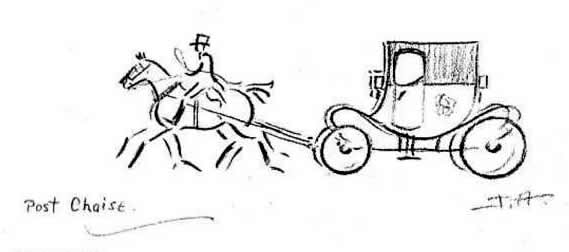
I am indebted to my wife for the suggestion she put forward which inspired me to compile this volume. When looking through my portfolios one evening she came across a few of my coaching sketches and suggested they would be ideal for book illustrations. After a long conversation that same evening it was decided that I should make as many paintings and sketches to make an interesting portfolio for publishing. I therefore have chosen and visited some of the old inns, on and in the vicinity of the Great North Road for my material. Some of the inns are still standing, others either demolished or re-constructed to meet more up-to-date requirements. The charm and flavour of the old coaching days are lost forever; modern road houses have taken the place of reputable hostelries, only a few of the latter remain. Maybe on the differences of the road-house and the coaching inn, I speak my mind as an artist and voice the opinion of a few, but then, that is the intention of this book, a collection of sketches from an artist's viewpoint. My thanks are due also to the landlords who gave me permission to sketch "on and off their premises" and for the many pleasant evenings spent in their company. Major J. Fairfax-Blakeborough needs no introduction in the sporting world and to him my deepest gratitude for such an excellent forward.

NEXT
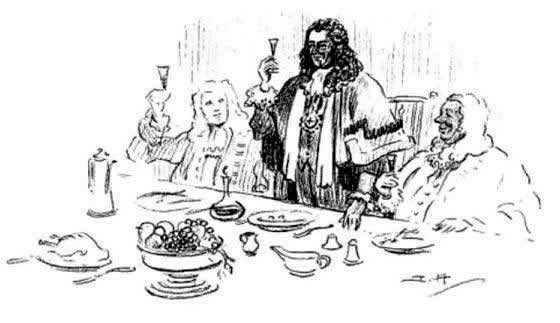
This Hostelry is reputed to have been one of the oldest establishments on the Great North Road and the most fashionable place of accommodation in Doncaster. Long before the advent of the coach, mails were conveyed from the inn on horseback and it was not until about 1790 that the first mail coach ran from here, although a coach had been calling at the "Red Lion" Doncaster since 1785. Excellent patronage was experienced at the "Old Angel" at assize time and it was the custom of the worshipful mayor and his Corporation to receive the judges at the borough boundary, escorting them with the ceremonial splendour to Rossington Bridge, on the completion of the law session. Services which connected London and Leeds and which stabled and changed horses at the time were the "Diligence" and "Rockingham". The popularity of the "Old Angel" as a posting house was short lived as the "New Angel" on the opposite side of the road secured the majority of the business when this inn was built in 1810.
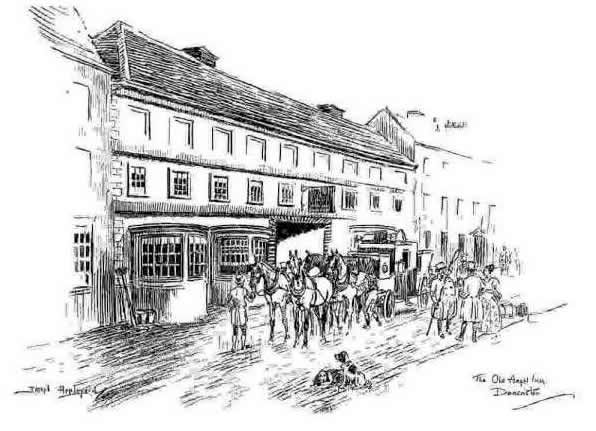
NEXT
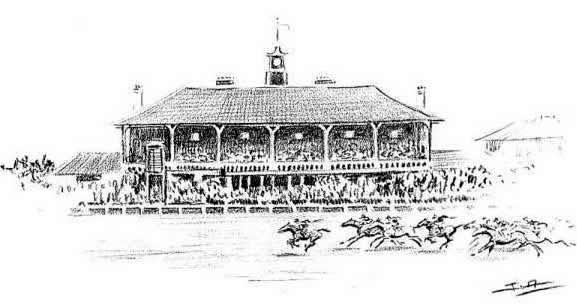
Instantly impressed upon the mind are these associations with Doncaster. On the St. Leger and Cup days it was customary for the London coaches to make a stay in the city until these races were over, when they proceeded on their journey and the "Salutation" was immensely popular in these intervals. What memories are recalled in the racing world with the names of "The Colonel", "Touchstone", "Persimmon", etc., when excitement and hopes were wont to wax high on the famous Town Moor. The townspeople then, as now, shut up shops, offices and establishments of employment and flocked in crowds to see the giants of the turf qualifying for the merits and prizes which were ultimately their due. Fortunes won! Fortunes lost in a matter of minutes! Such is the luck in the traditions of Classic racing. In alluding to the St. Leger we are reminded of the genius of F.C. Herring - delineator on canvas of most "Leger' winners of his time. In the early part of his career his painting associated harmoniously with another strong trait in his character - Driving! He drove the "Highflyer" Stage and was a superb coachman. On arrival in Doncaster at the age of nineteen he commenced painting inn signs and coach embellishments - Incidentally he was commissioned by the landlord to paint a sign for the "Salutation". Bradley mentions the fact that Herring "painted a picture of angels and not of men".
NEXT
This was known as a junction house, being an outlet for the heavy amount of road transport on the main road, where many of the mail coaches branched of on their various routes, the Edinburgh coaches by the Tadcaster road to York, the Newcastle coaches by way of Aberford and the Leeds traffic by way of Peckfield Bar. There were commodious rooms to the inn and in addition numerous buildings such as stables, coach and chaise houses, servants' and post-boys' quarters were attached to form one large centre of post house administration.
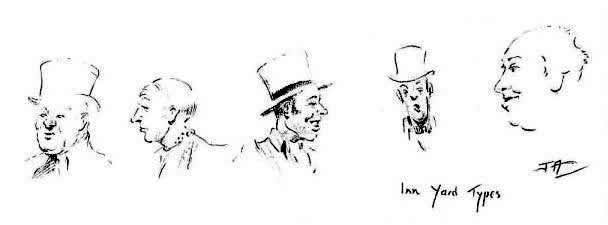
The management during the inn's prosperous days was ably fulfilled by the local doctor, who found relaxation from his medical practice by performing the duties of mine host. Many of his male patients suffering from business strain or mental depression he recommended to "drop in" for a "tonic" and consultation, usually nothing more than an honest to goodness chat on local or topical matters, Such was his method, simply a close study of human psychology! He was a dapper little man and was respected by all who visited or worked under him. Unfortunately, during my research I was unable to obtain a portrait of him to include at the foot of the text page. If I had sketched one from imagination it would certainly have been a countenance of intelligence and good humour.
THE 'ANGEL', FERRYBRIDGE
NEXT
Excellent progress has been made since leaving Grantham - in fact our coachman was a minute in hand at Bawtry.

Now we can trespass on those valuable seconds as the ostler checks the leaders. The proprietor has the mail bags at hand and the barman awaits with the usual foaming tankard for the coachman. Watches are checked, prepaid luggage is handed up to the guard, post bags are thrown into the boot, the lid closes with a bang! In as much time as these operations have taken the coachman has quaffed his pint. The ostler stands clear - the whip whisks over the leaders - a sudden lurch and the team bounds forward, once more on it's silvery way, with but one objective in view - Leeds!

NEXT
An exceptionally popular house in the hey-day of the road, with large stables and good staff employed for change of horses.
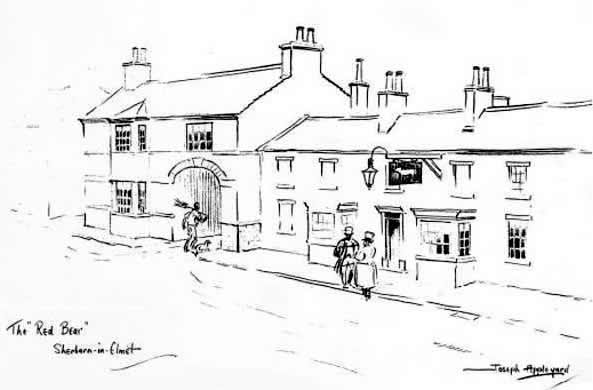

The appearance of the inn today is not greatly altered and the antique sign suggested in the sketch is no more.
NEXT
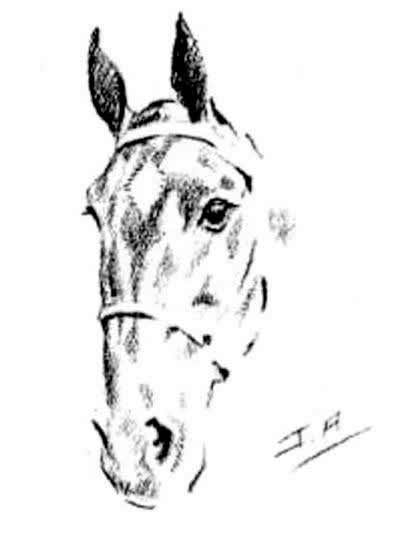
Two of the principal coaching houses of the period, when Tadcaster during the last century saw quite a large number of stage coaches, chaises, baggage wagons and strings of laden pack horses pass along it's main street.
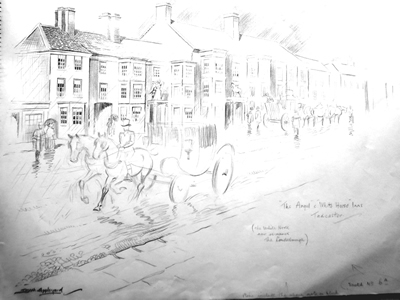
Although bearing signs of modern style in architecture, Tadcaster still retains many of it's old buildings which cannot help but lead us in imagination to what was no doubt a colourful and romantic age.
NEXT
These ancient houses, small in comparison to the other Leeds hotels, nevertheless were a valuable spoke in the wheel of the coaching industry, inasmuch that they operated a large proportion of the smaller transport services, such as short runs to Wakefield, Dewsbury, Huddersfield and the other West Riding Towns.

They were two of the oldest inns in the city. The "Old George" being perhaps the older dating back to 1690.
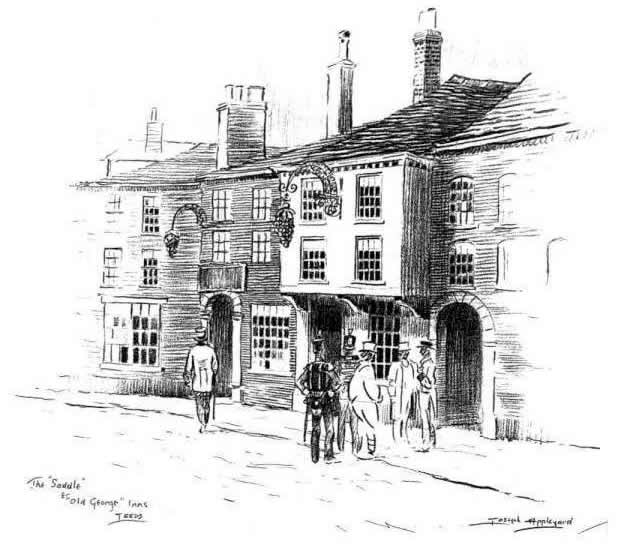
NEXT
This was situated in Boar Lane and was probably the most exclusive of the City's posting houses during the early part of the nineteenth century.
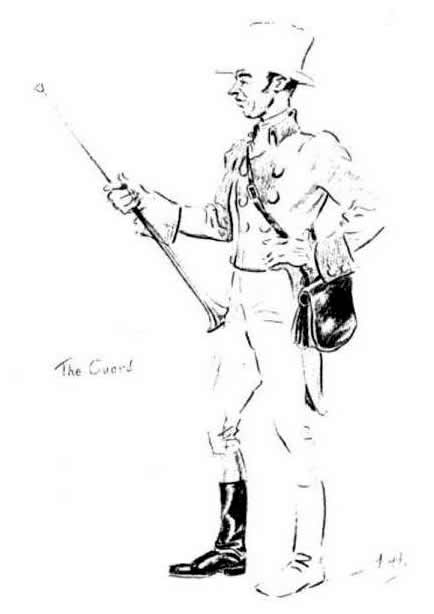
The rooms were spacious and elegantly furnished, affording luxurious comfort to the more prosperous farmers and fodder merchants who dealt at the Corn Exchange. Irrespective of these speculative visitors, the "White Horse" yard and stables were continually thronged with the heavy baggage wagon teams. It was a starting point for the majority of the Airedale and Craven mail coaches, supplemented by the London traffic - Each counterpart adding noisily to the clatter of hooves and the rumble of wheels, which continued well into the night.
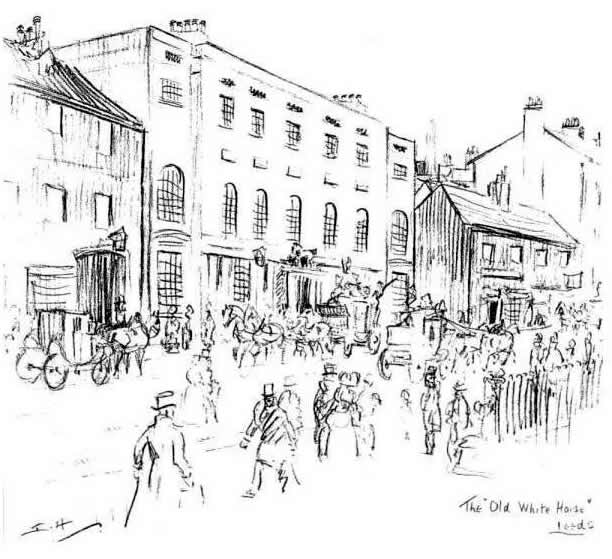
NEXT
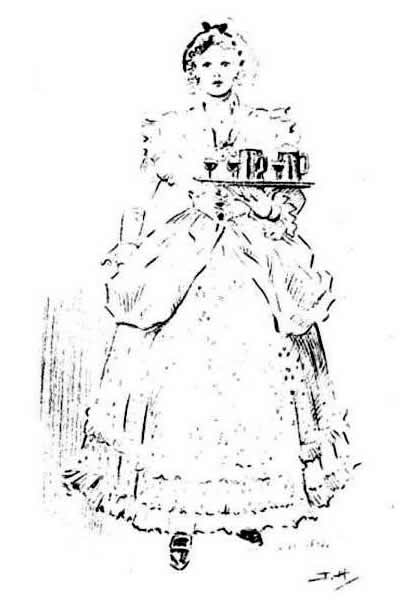
Every hour of the day they rattled over the stone sets of Briggate and endless streams of post chaises, wagons and horsemen jostled and crowded together in the roadway, whilst shoppers, tradesmen, shoe-blacks, vendors and sightseers thronged the pavement of the main thoroughfare of this prosperous and industrious West Riding city.
THE 'BULL AND MOUTH', LEEDS
NEXT
In 1863 this establishment was sold to Mr. Henry Crossley for £1,700. This gentleman being the founder of the Wetherby News and was also a master printer. There were stables for almost one hundred horses and forty pairs of horses were regularly kept for posting purposes. It was the chief posting house in Wetherby, whose streets at the time were enlivened by a vast traffic and was a notable place at which the coaches stopped to change horses. Situated on the Great North Road, (which involved the main street) it was at a point nearly midway between London and Edinburgh.

Cockfighting was include in the recreations of the townspeople, the cockpit being in the "Blue Anchor" yard; This inn was pulled down about the middle of last century.
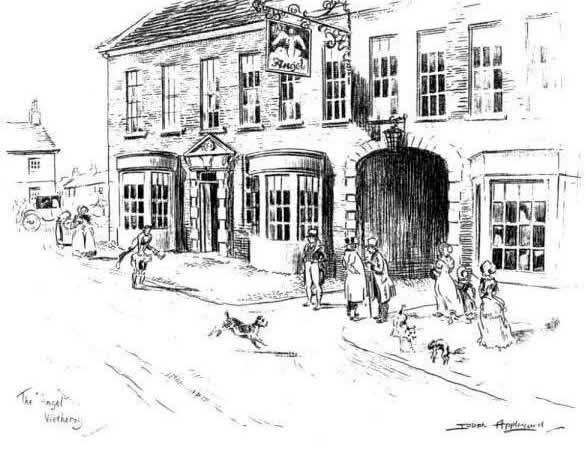
NEXT
This small inn was exactly half way between London and Edinburgh, the mile post was at the foot of the tree which held the sign.
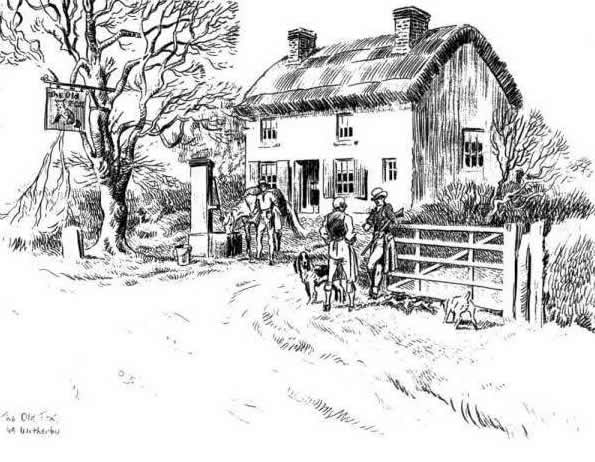
It was a frequent place of rest for the drovers who, even in those days were in the habit of "chalking up their drinks behind the door" until such times as they had safely delivered their cattle to the markets and would then have a "rollicking do" on the return journey.
NEXT
Although this was not a coaching inn, I have included it in the series, owing to its remarkably fine condition for a building so old.
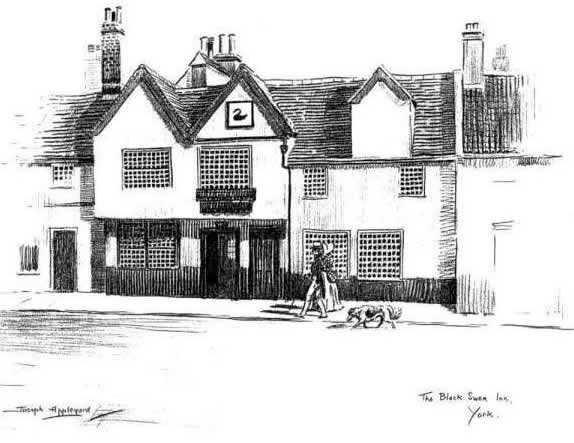
It surely must rank highly amongst the most picturesque of York's ancient buildings. As can be seen from the sketch it is only a small place, yet the interior seems larger than one would anticipate. Inside there is a beautifully carved oaken staircase and panelled rooms. Years ago the house was owned by the famous wealthy Bowes' family; today it is the property of a local brewery and is still run as a licensed inn.
NEXT
At last, we arrive at the threshold of a brightly painted inn, whose stately porch is crowned by a graceful model of a black Swan. It is a welcome sign for the hungry traveller. We are stiff and cramped, our vitals empty, feeling all the moreso by the tantalising smell of roast beef and Yorkshire pudding, issuing from the kitchen cellar gratings. Descending from our seat on top of the coach we do not feel the ground, because of a sudden attack of "pins and needles", but heedless of this, our be-numbed limbs convey us rather unsteadily into the hotel.
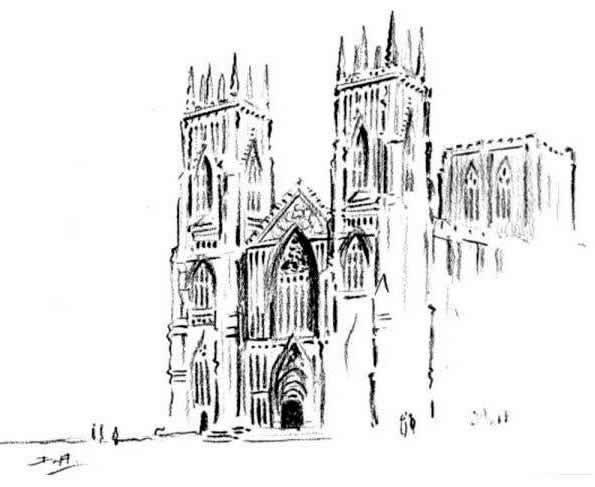
We follow the dandy (whose eloquence had bored us to distraction during the journey); however, knowing that he had been to the hotel before, we are thankful to let him take command in escorting us into the dining hall. The service is quick, for no sooner have the drinks been served by the wine steward, than a plate of hot piping soup is placed before us by a most charming waitress - she haughtily ignores a facetious remark passed by our gossiping friend. Roast beef, Yorkshire pudding and vegetables follow and do not belie the appetising aroma which met our nostrils a moment before. Coffee finished, we are summoned outside by the guard and coachman to resume our journey - Good care is taken not to sit within ear shot of the yapping dandy. The post horn rings out! ______ We're away!
THE 'BLACK SWAN', YORK
NEXT
What a contrast in appearance is the modern building of a leading drapery store compared with the beautifully carved old inn which once stood there.
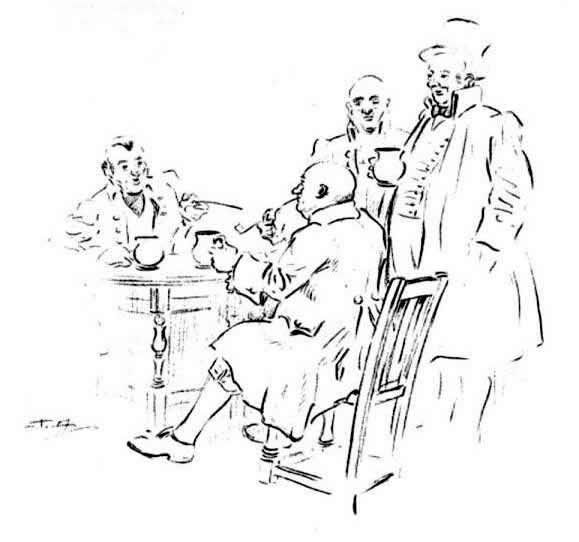
It was pulled down in 1808 and a more picturesque place would have been hard to find even in York. The "Old George" was one of the City's oldest buildings and the stone and woodwork on the face of the inn was exquisitely carved with ornamental designs (as can be seen from my sketch which was taken from a print of the period).
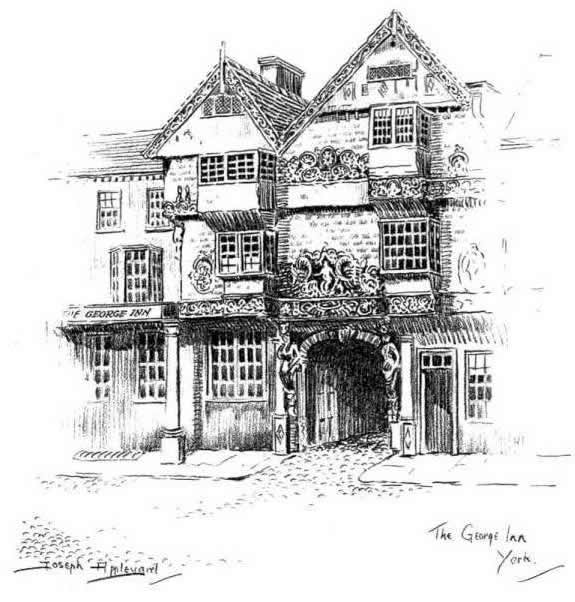
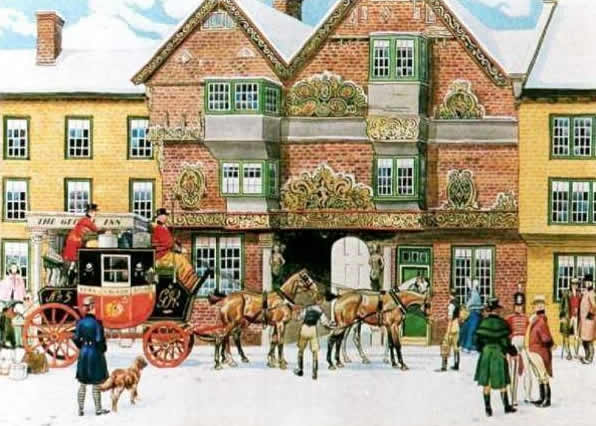
The inn at one time was the chief posting house in York and kept many changes of post horses in its stables. Very few coaches however called here, but it kept up a sound reputation as a popular "local" and was frequented by tradesmen and business-men from the doctor to the road sweeper.
NEXT
From York to Liverpool in one day! This was the record held by a special coach which left the "White Swan" every morning at half-past-eight, calling on its way at Leeds, Huddersfield and Manchester. Baggage wagon horses were also stood in the commodious stables at the "White Swan" premises in The Pavement.

These teams and their lumbering wagons loaded with heavy goods were a familiar sight on the roads during the coaching age and one can well imagine the curses and oaths exchanged between the driver of such a vehicle and the man on the box of the coach, when they became involved in a "traffic jam" on some of the narrow roads. The wagons attached to these houses conveyed goods between York, Sheffield and Doncaster.
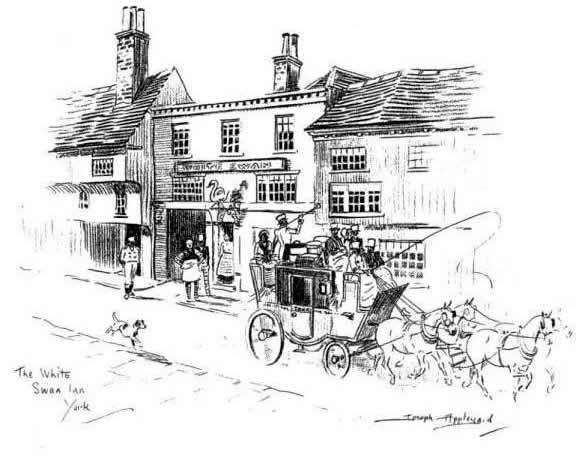
The principal coach services operating from the "White Swan" were the Sheffield "Accommodation" and a very excellent service, The "Royal Union", which had two main routes to cover each day, one from Leeds to Scarborough and the other from York to Hull, terminating at the Humber Tavern.
NEXT
Very few coaches visited the "New Inn" but the premises were used in the execution of Royal Mail duties and in the inn was an essential link in the long chain of post houses on the Great North Road.
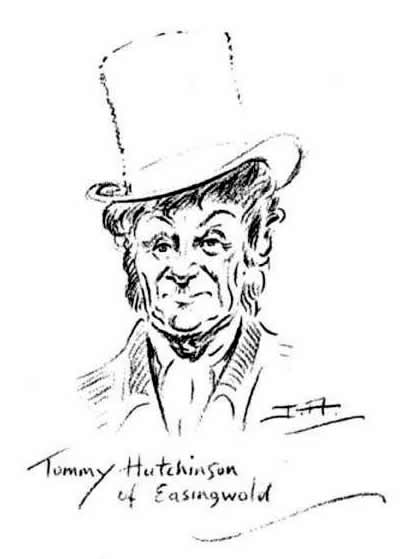
The "Rose & Crown" was the busier of the two places, being a prominent building commanding a good position in the High Street. Equally famous as the inn was one of its post boys, Tommy Hutchinson, who created a record by riding one hundred and thirty miles in one day - this involved five journeys to York and back.
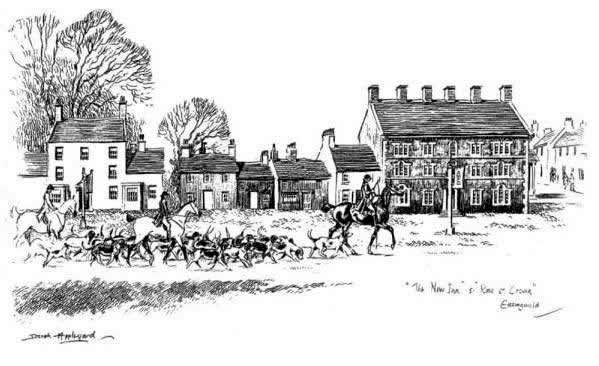
This performance according to Bradley was exceeded by one, John Lepton of York, who, for a wager rode for six successive days a daily distance of one hundred and fifty miles on the London to York road.
NEXT
"Good stabling and accommodation" was the axiom of this well known market place inn. The posting and travel business was established after the transfer already mentioned of the London to Edinboro' Service from the "Three Tuns" by Mr. George Blythe. At the same time this gentleman founded a competitive coach, to oppose the one already operating between Leeds and Newcastle which was still calling at the "Three Tuns". The new coach, the "North Highflyer" soon proved very popular. It was built for speed, only the best and fastest horses were used, To cut down the time schedule luggage limitations were imposed and a shorter route through Harrogate and Knaresborough was used. About this time were various other mail coaches running between Newcastle and Leeds. Two more, the Newcastle to London and Edinburgh to London vehicles were calling at the "Golden Fleece" both day and night. Picture these four-in-hands galloping into Thirsk market place, hoofs and wheels clattering on the cobbled stones; pole chains jingling, leather creaking, accompanied by the mellow tones of the post horn. Then the "Whoa mi' beauties!" from the driver as he pulls in the ribbons to check his team and brings his coach to a standstill.
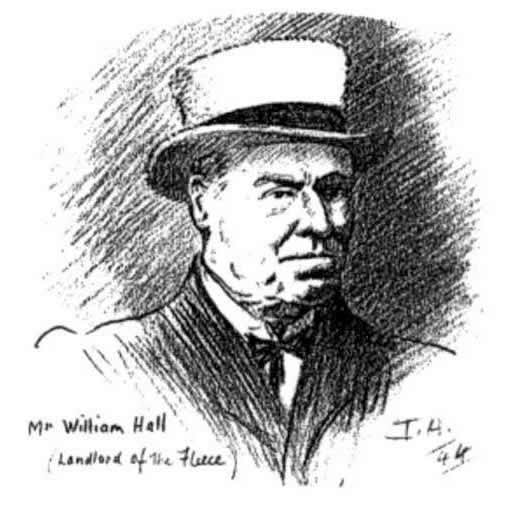
About 1840 when the posting business was at it's height, a Mr. William Hall became the landlord of the "Golden Fleece". Being only twenty-one it must have been a tremendous task for one so young to manage the stabling, feeding and grooming of sixty horses. Apart from handling a large staff, young Hall also had the catering and accommodation side of the business to attend to and the great responsibilities which mails and luggage entailed. There were the large numbers of farmers and tradesmen who frequented the market and flocked to the "Golden Fleece" for food and drink. Busy as he was he enjoyed every minute of his days and lived to a ripe old age. Having the bustle and excitement of coaching it must indeed have been a blow to him to see the passing of this romantic form of transport, in favour of more modern methods, a change which took place shortly after his death.
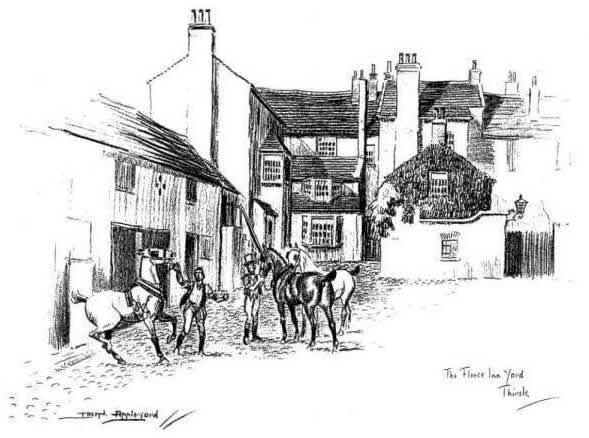
(COLOUR PLATE MISSING)
NEXT
The first coaching house in Thirsk. Here most of the principal northward bound coaches were horsed.
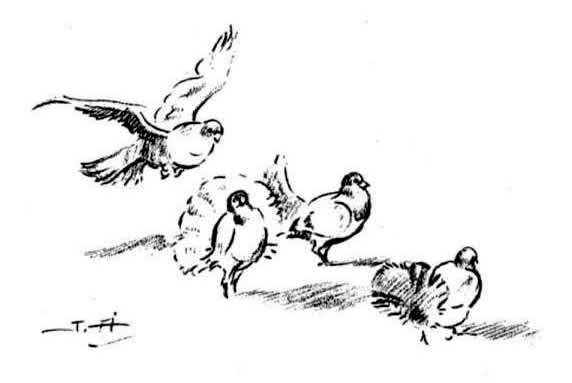
The London to Edinburgh vehicles were later transferred from the "Three Tuns" to the "Golden Fleece", but the Leeds to Darlington ones remained with the "Three Tuns' until the end of the coaching period.

NEXT
Long before we reach the outskirts of Northallerton we are aware of the fact that it is market day. It becomes more apparent to the casual observer riding on the top of the coach, as we pass farm gigs driven by their owners, laden with barrels of apples, baskets of eggs, cheeses, butter, jams and various other home made produce. One rather large pig cart is passed loaded to capacity with snorting porkers and squealing piglets whilst perched precariously on the seat next to the jovial driver is a basket-like crate containing whistling goslings. The driver waves his hand and wishes us the top of the morning. As we get nearer the town we pass a never ending stream of horses and cattle and the throng increases. Our coachman slows his team down as we enter the High Street filled with gaily coloured stalls, the buyers and sellers mingling in and among, forming a scene which gladdens the heart of every North Riding man. Unfortunately our stay is too short even to have a quick glance around the market. Worse luck - it is the day of the ever popular horse fair.
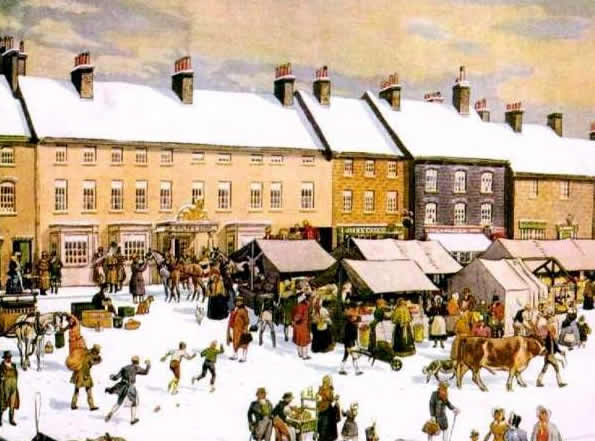
THE 'GOLDEN LION', NORTHALLERTON
NEXT
Only a few horses were kept here, as the stable room was small, incidentally there would be no more than about three coaching services using the amenities of the inn.
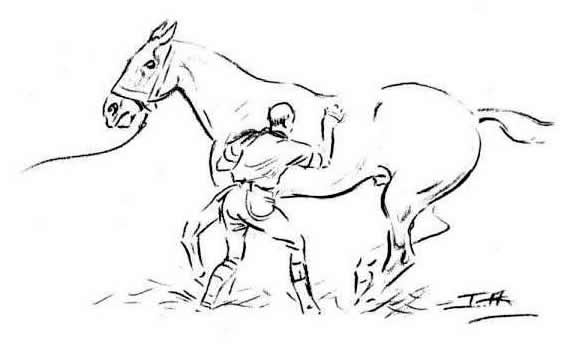
A good type of coaching inn, though I believe not as well staffed as it's neighbours.
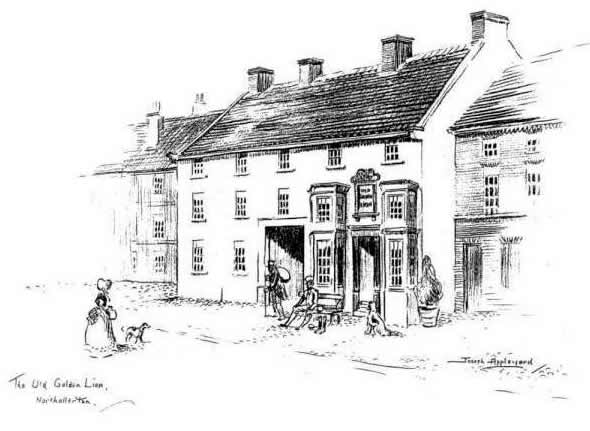
NEXT
The first mail coach operating up North went to the old "Black Bull", since when, the inn was extensively used by the many Mail Coach Services and the Leeds to Newcastle Expresses.
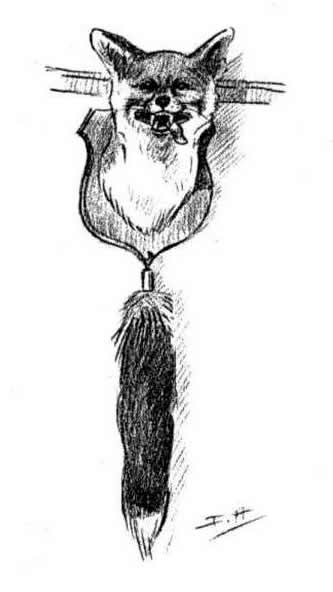
To-day shops merge into the structure of this once fine old house, but the archway leading to the yard and stables is still there - a silent sentinel to the active vehicular scenes of yesterday.
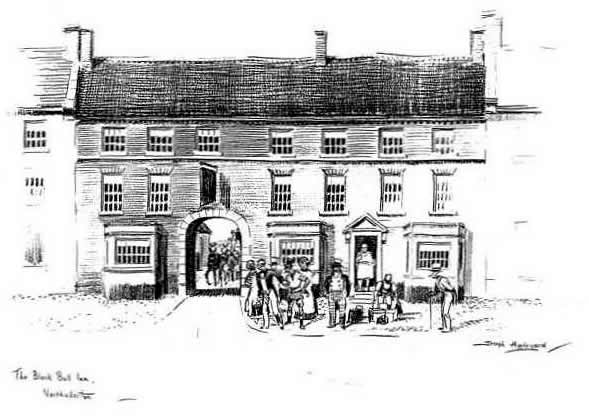
NEXT
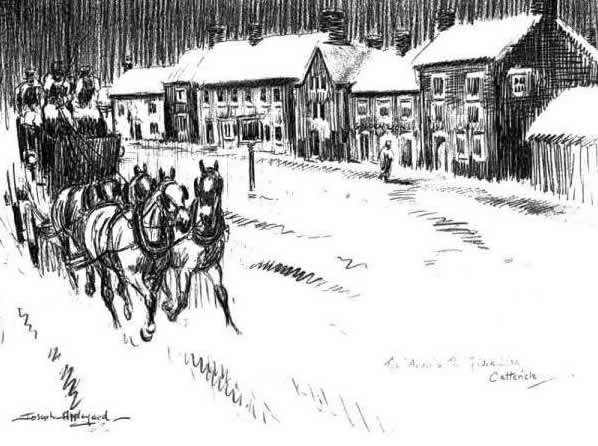
THE 'ANGEL' AND 'GOLDEN LION' INNS, CATTERICK The "Angel" was not a busy coaching house even in view of the fact that there was stabling room for upwards of a hundred horses. The reason for this amount of stable room was due to the fact that the place was used as a breeding establishment for hunting and coaching horses, in addition to being leased at Catterick race meetings to the local gentry who preferred to hack to the races. The "Golden Lion" was managed in it's balmy days by one, Joseph Scott, who himself was no novice in the "handling of fours bits of blood", having held the position of coachman before his marriage, on a coach service between Durham and Leeds. Page No TOP ,I,II,III,IV,V,VI,1,2,3,4,5,6,7,8,9,10,11,12,13,14,15,16,17,18,19,20,21,22,23,24,25,26,27,28,29,30,31,32,33,34,35,36,37
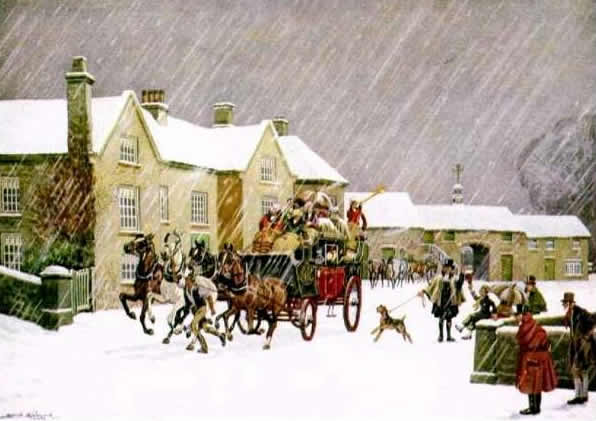
Now known to present day people as the "Bridge" Inn, the "George" was one of the best known sporting houses on the Great North Road. Not only was it made popular by the attendance of the race meetings at Catterick, but there was always some form of sporting attraction, whether it be cock-fighting, pugilistic contests or heavy weight wrestling, there was always a large following assembled in the garths adjoining the inn, where the sporting was displayed.
NEXT
It must have been an exciting time at the Inn when the sporting matches were held between the fast trotting horses on that stretch of the road known to us as Leeming Lane. 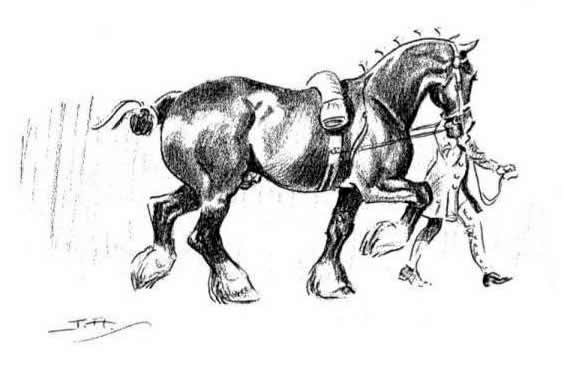
Horseman came from all over the county, even from, the "Shires" and hunting counties of the Northern Midlands. In the district, can still be seen old prints depicting this form of exhilarating equine sport. Travelling agricultural stallions often occupied the stables at the "New Inn" and here again, the horse loving Yorkshireman would congregate and over a pint of ale would discuss horses from every angle.
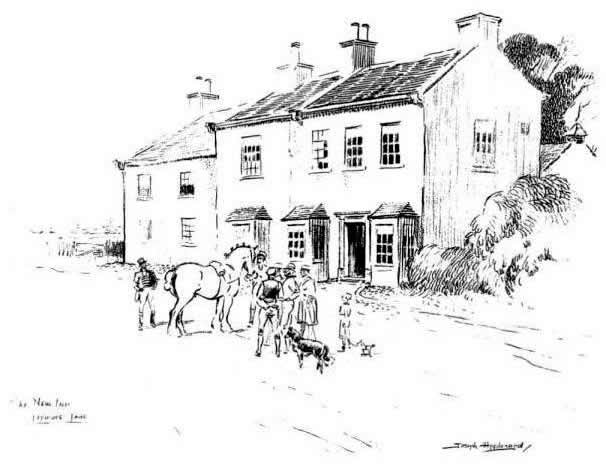
NEXT
Perhaps the most enjoyable part of a coaching journey would be to jog along on a scorching day and view the activities of the farmer in his fields cutting and loading hay. To pass here and there on the roads suchlike wagonloads thronged with bright faced children laughing and singing.

Of course I am speaking chiefly of the outside passengers' viewpoint from the top of the coach, whose face would be nicely tanned and would in all probability be quite thirsty, but this would be adequately provided for on reaching the "Three Tuns" at Scotch Corner at about tea time and drinks of tea or ale would no doubt be appreciated by all, whilst horses were watered, or changed in the few minutes interval - then on and away to Darlington in the cool of the evening feeling much better for the hospitality.
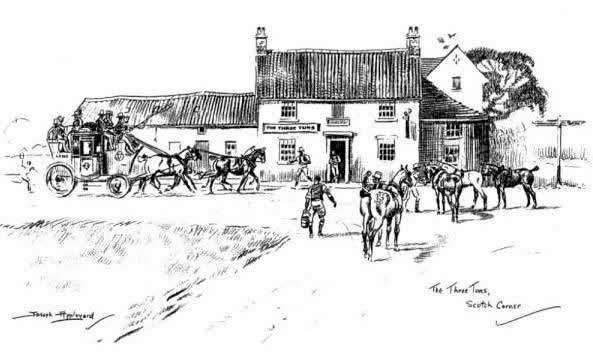
NEXT
This picturesque building overlooks the square of Ryedale's old market town, which is far removed from the hustle and bustle of the Great North Road. It was a posting house and a port of call for the drovers with their pack horses, who stayed the night for a well earned rest after a gruelling day over the Cleveland and Bilsdale moors en-route for the industrial areas.
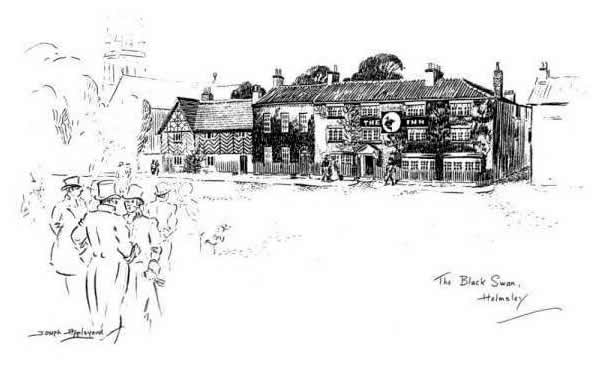
THE 'BLACK SWAN', HELMSLEY The old stables still stand as a reminder of those days.
NEXT
It is assumed that this place was the one which Charles Dickens introduced in his "Nicholas Nickleby", where the bags alighted from their coach journey from London before resuming their way by cart to Dothebey's Hall. The "George" was pleasantly situated at the end of the balustraded bridge which spans the river Tees at one of its' most beautiful spots.
THE 'GEORGE INN', GRETA BRIDGE
NEXT
A Turnpike Act was solved as early as 1662, with amendments from time to time, wherein tolls were charged at frequent intervals on the coach roads, for the construction, repairs and upkeep of stretches of road between the different turnpikes. Gates or Pikes, were more frequent on the roads the nearer one got to the towns. Many are in good preservation today, being used as labourer's cottages, or in some cases, transformed into small wayside transport cafes.
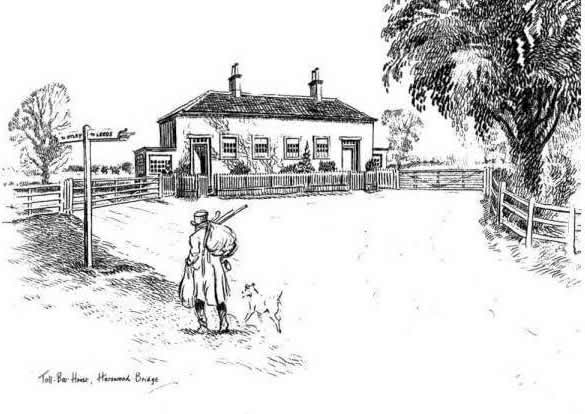
NEXT
A glance through the window of our coach would often reveal such splendid halls and mansions as the one illustrated, for Yorkshire abounds in them.

Standing amidst the cool trees they must have oft gladdened the eye of the dusty traveller with the appearance of stateliness and repose,

THE HALL. SHERRIFF HUTTON PARK But anon, we are concerned with inns, so must whip up our horses.
NEXT
Whenever I visit market towns I invariably conjure up pictures in my imagination of the olden days, when inns, horses, coaches, passengers and grooms must have been interesting as well as exciting.
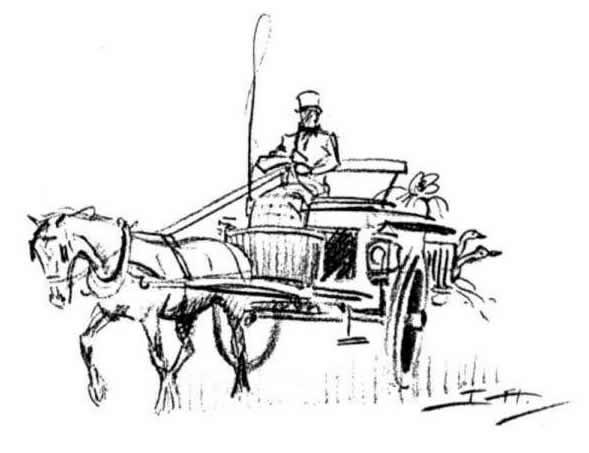

What good material this must have afforded the sporting painters of the day, examples of which have luckily survived and been handed down to the present day. Pollard, Cooper-Henderson, Fernely, Alken and Herring to mention a few of these intrepid artists.
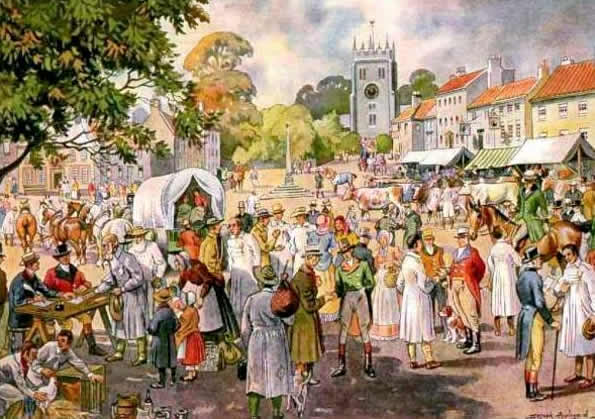
Page No TOP ,I,II,III,IV,V,VI,1,2,3,4,5,6,7,8,9,10,11,12,13,14,15,16,17,18,19,20,21,22,23,24,25,26,27,28,29,30,31,32,33,34,35,36,37
The accompanying sketch is an adaption from an old colour print of this express mail coach, which under favourable weather and travelling conditions invariably ran to the second.
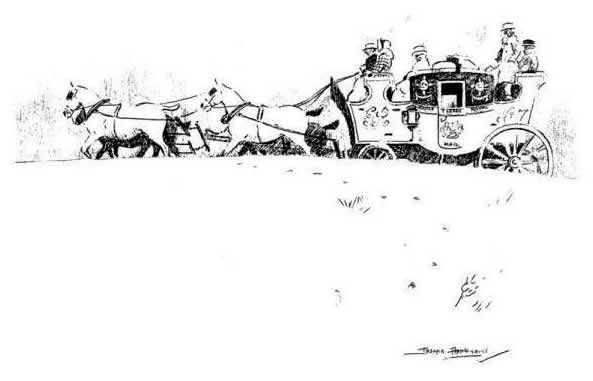
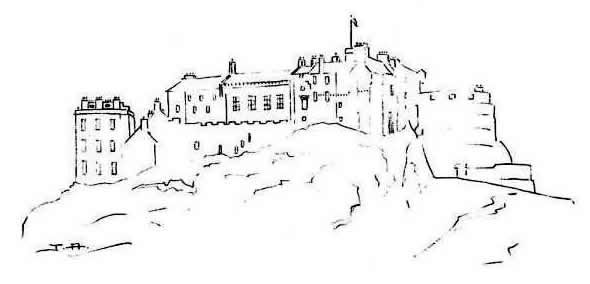
EDINBURGH CASTLE It was eagerly awaited by the Northern townsfolk and villagers for first-hand news and gossip from London.
NEXT
A LIGHT POST HORSE The Yorkshire Coach Horse which was a distinct breed and mostly used for the mail coaches, owes its' origin to those days when a demand for the light and stylish harness horses caused the Cleveland Bay to be extensively crossed with the thoroughbred, consequently the coach horse possesses more quality than the Cleveland and is the more breedy looking horse.
COACH HORSES
NEXT
These horses were chiefly employed for carrying the bales of wool from the Dales to the quickly prospering West Riding industrial towns. The horses or ponies travelled the old pack horse roads which are to be found on the fells and in the Dales of the county; this mode of transport was used up to the commencement and during the coaching system. With the introduction of paved roads in the industrial areas, it became much easier for the ponies engaged upon this traffic.

Cleveland bays were used as pack horses although there was a good specimen imported from Germany which was a large sized pony, the Cleveland being adopted later for the coaches.
NEXT
Much has already been written about these romantic heroes. Dick Turpin is immortalised in Harrison Ainsworth's "Rookwood" and Claude Duval is much perpetrated in novels and narratives.
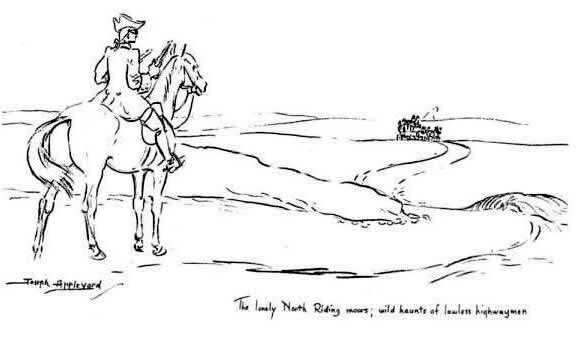
Their association with the various inns is notorious. Even today their stories are re-told by mine host in many such hostelries. No doubt these oft-repeated stories glorify the highwayman, but in the coaching days he was regarded only as "a dastardly, horse thieving, coach robbing villain".
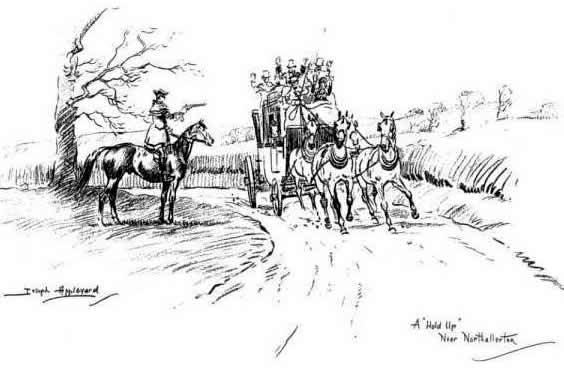
NEXT
This gentleman's service was called upon at all hours of the day and night. Nothing was too much for him in the following of his craft, whether it be the rectifying of any shoeing on the horses or smithy work on the coach.

THE BLACKSMITH Truly speaking he was the "Gentleman of the Road" and not the highwayman.
NEXT
Weary, dusty, cramped and stiff we at least arrive at the end of our tiresome journey. The male passengers dismount from the top of the coach and help the ladies to alight from inside. The nimble guard jumps to the ground and opens the lid of the boot, leaving the handling of the luggage to the hotel porters, he bounds again on top and unlocks his box seat wherein the valuable mail packages are kept. These are signed for and handed to the official resident postmaster of the hotel. The passengers bid each other farewell or stand around the porchway of the hotel, some follow the porters inside, who have taken custody of their luggage. The ostlers are heard shouting to the coachman in good humour - this worthy is sat on his box seat yawning away for all he is worth and "doesn't care a damn whether he sleeps on 't top o' 't coach all neet!" He didn't comply with his statement however, as the back kitchen of any inn can be a comfortable spot, as one will see in a moment.
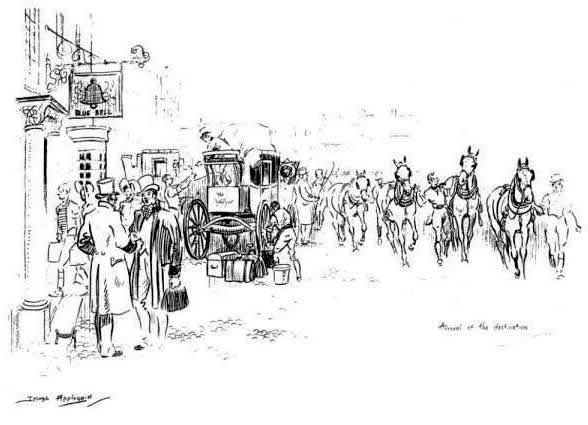
NEXT

On glancing back over the sketches I have made, I hope to have given a slight impression of the coaching age of the Great North Road and if I have afforded my reader a few moments pleasure then my enterprise is amply rewarded.
Page No TOP ,I,II,III,IV,V,VI,1,2,3,4,5,6,7,8,9,10,11,12,13,14,15,16,17,18,19,20,21,22,23,24,25,26,27,28,29,30,31,32,33,34,35,36,37 Joseph Appleyard If you have enjoyed your visit, or
know of the whereabouts of any of Joe's work, please e-mail |


